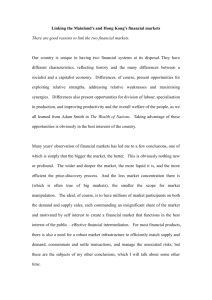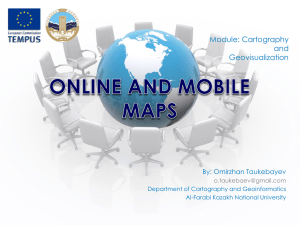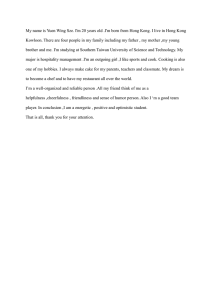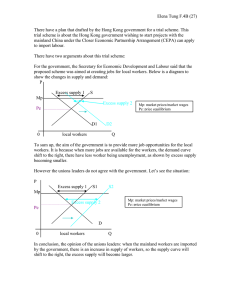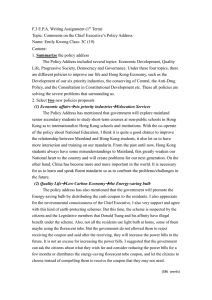IELTS Writing Task 1: Graph Description Guide
advertisement
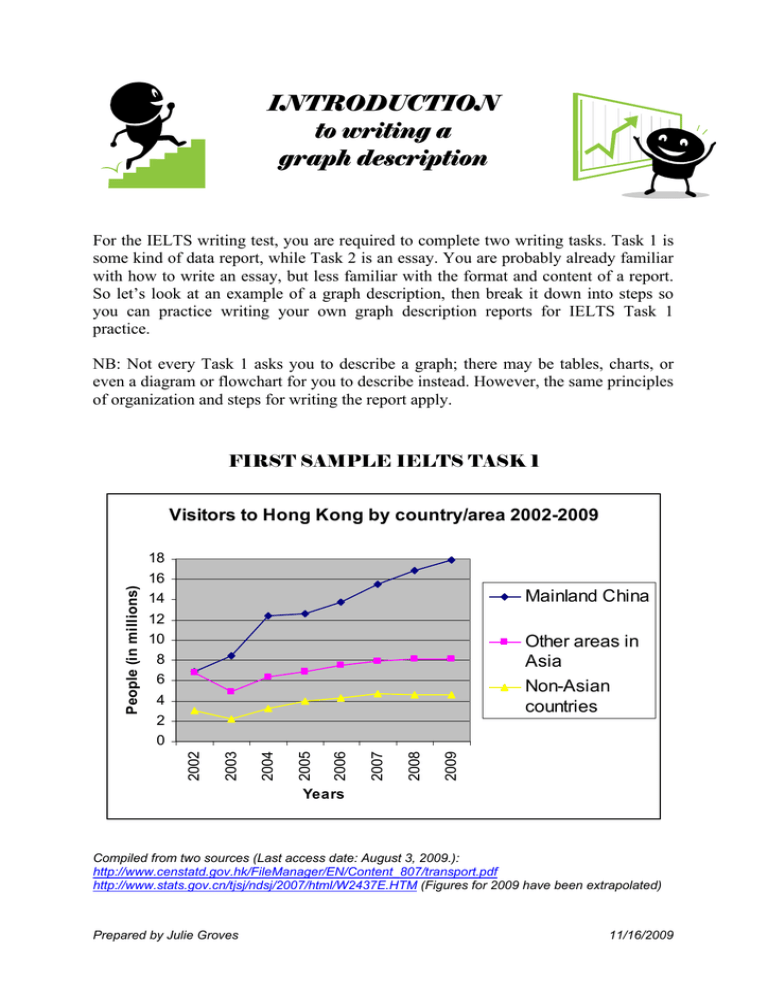
INTRODUCTION to writing a graph description For the IELTS writing test, you are required to complete two writing tasks. Task 1 is some kind of data report, while Task 2 is an essay. You are probably already familiar with how to write an essay, but less familiar with the format and content of a report. So let’s look at an example of a graph description, then break it down into steps so you can practice writing your own graph description reports for IELTS Task 1 practice. NB: Not every Task 1 asks you to describe a graph; there may be tables, charts, or even a diagram or flowchart for you to describe instead. However, the same principles of organization and steps for writing the report apply. FIRST SAMPLE IELTS TASK 1 18 16 14 Mainland China 12 10 8 6 Other areas in Asia Non-Asian countries 2009 2008 2007 2006 2005 2004 2003 4 2 0 2002 People (in millions) Visitors to Hong Kong by country/area 2002-2009 Years Compiled from two sources (Last access date: August 3, 2009.): http://www.censtatd.gov.hk/FileManager/EN/Content_807/transport.pdf http://www.stats.gov.cn/tjsj/ndsj/2007/html/W2437E.HTM (Figures for 2009 have been extrapolated) Prepared by Julie Groves 11/16/2009 Sample Report 1 – Model Answer The graph shows the number of travelers from various parts of the world entering Hong Kong for the years from 2002 to 2009. It can clearly be seen that there has been* a large increase in the number of Mainland Chinese visitors, while figures for visitors from Asia as well as other areas of the world have only shown* a slight growth. The numbers of Mainland Chinese visiting Hong Kong have risen considerably over this time period. In 2002 there were nearly 7 million Mainland Chinese visitors, similar to the figure for other parts of Asia and just over double that for non-Asian travelers. This number climbed to approximately 8 million in 2003, then rose dramatically by 4 million to just over 12 million only one year later. Since 2004 there has been a steady increase, with around 18 million Mainland Chinese travelers visiting Hong Kong in 2009. This is more than double the number for that year of other visitors from Asia, and around four times the figures for non-Asian visitors. The figures for travelers from other parts of the world show similar trends: first a dip of roughly one-third the total number of visitors from 2002 to 2003, then slow growth until 2007 followed by a leveling out. Overall, the numbers of Asian tourists rose by 1 million from just under 7 million in 2002 to roughly 8 million seven years later, while the corresponding figures for visitors from non-Asian parts of the world were roughly 3 million and 4.5 million respectively. To sum up, in recent years Hong Kong has become an increasingly popular destination for visitors, especially people from mainland China who currently outnumber those from all other parts of the world combined. (287 words) * Please note that this description was written in 2009, hence the use of the present perfect to describe trends which began in the past but which have continued up to the present time. Stop and Think! What is the function and content of: … the red sentence? … the blue sentence? … the green sentences? … the brown paragraph? What verb tense(s) is/are used for each section? Why? Now let’s read on and take a look at the steps that you could take to write a report like the above. Prepared by Julie Groves 11/16/2009 STEPS for writing a graph description Step #1 Read the title and labels on the graph as well as the instructions. Æ Note down 2-3 synonyms for key words/phrases. Æ Write your introductory sentence, trying not to copy any phrases. Step #2 Analyze the information in the graph, looking at the overall trend(s). Æ Write the rest of your introduction, explaining the main trend(s). Step #3 Plan your body paragraphs (probably one paragraph for each main trend). Æ Draft a topic sentence for each body paragraph. Step #4 Choose the most important details that will support your statement(s) of main trend(s). Æ Write the rest of the body paragraphs. Æ Remember to include key figures from the data. Step #5 Think about how to restate the main trend(s) in the graph using different words. Æ Write your conclusion, paraphrasing the main trend(s). Step #6 Proofread your description. Check: Æ Grammar: Accuracy of noun phrases and verb phrases, correct verb tenses & prepositions. Æ Organization/coherence: Linking words and variety of phrases/conjunctions. Æ Content: Is the information accurate and detailed enough? Do the details support the topic sentences? Prepared by Julie Groves 11/16/2009 Now try this process yourself, with a different graph. Work through the 6 steps. When you have finished, compare your answer with the sample answer (below). (Note that this is not the only possible answer, nor the only possible way to describe the trends in this graph.) SECOND SAMPLE IELTS TASK 1 The graph below shows permanent and long-term arrivals in New Zealand by country of origin in August of the years 2007 to 2009. Write a report of at least 150 words describing and comparing the data. 600 500 400 Aug-07 300 200 Aug-08 Aug-09 Germany France Hong Kong Mld China USA 100 0 Canada Number of people Permanent and Long-term Arrivals in New Zealand by country of origin My notes Prepared by Julie Groves 11/16/2009 Sample Report 2 – Model Answer The graph shows the number of immigrants to New Zealand from various parts of the world for the month of August in the years 2007 to 2009. Different trends can be seen for people arriving from North America, Asia and Europe, while immigrants from Mainland China showed the greatest increase as well as made up the largest proportion of immigrants throughout most of this time period. The figures for people moving to New Zealand from different regions of the world showed diverse tendencies. The numbers of North American immigrants firstly peaked at a little over 150 for Canada and just under 400 for the USA in August 2008, then declined by around 60 to 80 the following year. Long-term arrivals in New Zealand from two European countries showed a continuous slight rise, with numbers of French and Germans reaching around 70 and 310 in 2009 respectively. In contrast, the figures for permanent arrivals from two Asian regions, Hong Kong and Mainland China, showed completely different trends. The number of Mainland Chinese immigrants grew sharply, almost doubling from about 300 in August 2007 to approximately 550 in 2009, comprising the largest group by 2009, around twice the size of the groups from America and Germany. On the other hand, numbers of Hong Kongers settling in New Zealand remained stable at roughly 50 per year, only around one-tenth the numbers of Mainland Chinese in 2009. To sum up, areas in three different continents displayed different trends. The numbers for mainland Chinese immigrants rose most dramatically and in 2009 represented the largest group, while Hong Kongers comprised the smallest numbers. (267 words) Prepared by Julie Groves 11/16/2009
